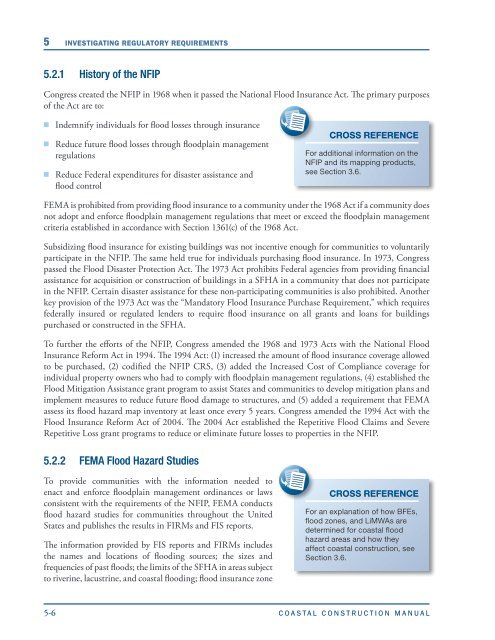Coastal Construction Manual - National Ready Mixed Concrete ...
Coastal Construction Manual - National Ready Mixed Concrete ...
Coastal Construction Manual - National Ready Mixed Concrete ...
You also want an ePaper? Increase the reach of your titles
YUMPU automatically turns print PDFs into web optimized ePapers that Google loves.
5 INVESTIGATING REGULATORY REQUIREMENTS<br />
5.2.1 History of the NFIP<br />
Congress created the NFIP in 1968 when it passed the <strong>National</strong> Flood Insurance Act. The primary purposes<br />
of the Act are to:<br />
<br />
Indemnify individuals for flood losses through insurance<br />
<br />
Reduce future flood losses through floodplain management<br />
regulations<br />
<br />
Reduce Federal expenditures for disaster assistance and<br />
flood control<br />
CROSS REFERENCE<br />
For additional information on the<br />
NFIP and its mapping products,<br />
see Section 3.6.<br />
FEMA is prohibited from providing flood insurance to a community under the 1968 Act if a community does<br />
not adopt and enforce floodplain management regulations that meet or exceed the floodplain management<br />
criteria established in accordance with Section 1361(c) of the 1968 Act.<br />
Subsidizing flood insurance for existing buildings was not incentive enough for communities to voluntarily<br />
participate in the NFIP. The same held true for individuals purchasing flood insurance. In 1973, Congress<br />
passed the Flood Disaster Protection Act. The 1973 Act prohibits Federal agencies from providing financial<br />
assistance for acquisition or construction of buildings in a SFHA in a community that does not participate<br />
in the NFIP. Certain disaster assistance for these non-participating communities is also prohibited. Another<br />
key provision of the 1973 Act was the “Mandatory Flood Insurance Purchase Requirement,” which requires<br />
federally insured or regulated lenders to require flood insurance on all grants and loans for buildings<br />
purchased or constructed in the SFHA.<br />
To further the efforts of the NFIP, Congress amended the 1968 and 1973 Acts with the <strong>National</strong> Flood<br />
Insurance Reform Act in 1994. The 1994 Act: (1) increased the amount of flood insurance coverage allowed<br />
to be purchased, (2) codified the NFIP CRS, (3) added the Increased Cost of Compliance coverage for<br />
individual property owners who had to comply with floodplain management regulations, (4) established the<br />
Flood Mitigation Assistance grant program to assist States and communities to develop mitigation plans and<br />
implement measures to reduce future flood damage to structures, and (5) added a requirement that FEMA<br />
assess its flood hazard map inventory at least once every 5 years. Congress amended the 1994 Act with the<br />
Flood Insurance Reform Act of 2004. The 2004 Act established the Repetitive Flood Claims and Severe<br />
Repetitive Loss grant programs to reduce or eliminate future losses to properties in the NFIP.<br />
5.2.2 FEMA Flood Hazard Studies<br />
To provide communities with the information needed to<br />
enact and enforce floodplain management ordinances or laws<br />
consistent with the requirements of the NFIP, FEMA conducts<br />
flood hazard studies for communities throughout the United<br />
States and publishes the results in FIRMs and FIS reports.<br />
The information provided by FIS reports and FIRMs includes<br />
the names and locations of flooding sources; the sizes and<br />
frequencies of past floods; the limits of the SFHA in areas subject<br />
to riverine, lacustrine, and coastal flooding; flood insurance zone<br />
CROSS REFERENCE<br />
For an explanation of how BFEs,<br />
flood zones, and LiMWAs are<br />
determined for coastal flood<br />
hazard areas and how they<br />
affect coastal construction, see<br />
Section 3.6.<br />
5-6 COASTAL CONSTRUCTION MANUAL







